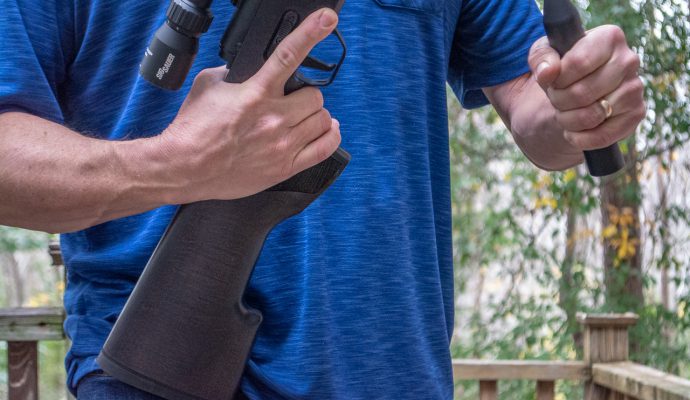
Let’s start today’s discussion with a pop quiz. Which of these activities is most likely to result in loss of a body part?
- Trimming your fingernails with a circular saw
- Checking the condition of your 1973 Chevelle serpentine drive belt while the engine is running.
- Cocking a break-barrel airgun incorrectly.
OK, so we probably should have included an “all the above” option, but here’s the important point. Cocking and loading a break-barrel (or under or side lever) air rifle requires care and proper procedure unless you want to lose your texting fingers and destroy your fancy air rifle.
But how can that be? It’s just an air rifle. The loading process couldn’t be more intuitive. After all, you just fold it in half, drop a pellet in the hole, close, and fire. Easy peasy, right? Aren’t instructions just a waste of perfectly good paper that could be used for something more productive? Like targets? Yes, but…
Here’s the thing. Even a simple break-barrel air rifle stores a lot of energy. Manufacturers implement many nifty quantum physics tricks to reduce the force required to cock one, but you’re still compressing a gas piston or spring with 150 pounds of force give or take – depending on the model. You don’t feel that because of those clever science tricks. With most airguns, your arms and shoulders might have to deliver between 25 and 50 pounds of force to pack that 150 pounds of raw energy into the action. It has something to do with Archimedes claiming “Give me a place to stand and with a lever I will move the whole world…,” but I digress.
So, envision this. After breaking the action, we’ve now got an air rifle storing 150 pounds of force while it’s in the open position. What if something goes wrong and the spring or piston releases? You now have a “potential” barrel tomahawk capable of removing your fingers as it slams shut. Remember, you’re loading this rifle right in the area where the action closes so your loading fingers are squarely in the guillotine zone. Not only do you risk losing body parts, your rifle will almost certainly be destroyed in the process. Which is worse? That’s your call but new fingers aren’t cheap.
Before everyone panics, remember that manufacturers implement many clever mechanical safeties to prevent such a catastrophe. However, being safe shooters, we all want to take steps that don’t require reliance on a mechanical device. You would never point a firearm at someone’s face and claim it’s OK because the safety is engaged, right?

Let’s review the proper steps to safety load a break-barrel. We’ll use the brand new, (and very sweet) Sig Sauer ASP20 air rifle as our model. Stay tuned, we’ll be taking a close look at this rifle just after the holidays.
- Make sure your finger is out of the trigger!
- Seat the buttstock on your hip. I find it easier to place it in the pocket where the top of my leg meets my body, so it sits on my firing hand side. You can hold the receiver in front of the trigger area or using a firing grip with your finger outside of the trigger.
- With your support hand, give the muzzle a firm “slap” downward to overcome the locked barrel pressure.
- Grasp the muzzle, as far forward as you can to better leverage and pull the barrel down. Be sure to move it all the way to the “fully open” position. Some rifles have a safety that engages the end of the cycle so it might require a little extra “oomph” at the end of its travel. You should hear and feel a “click.”
- Now here’s the important part. Keep holding the muzzle with your support hand. Do NOT let go.
- Since the buttstock is seated in your hip area, you can use your firing hand to load a pellet into the breach. This keeps your support hand free to keep holding the barrel securely.
- Move your firing hand back to the grip area. You can now close the barrel with your support hand until it locks into place.
That’s it! The key is that you never, ever let go of the barrel with your support hand. That way, if something breaks loose, you have a hand on the barrel to prevent it from snapping closed like gator jaws and damaging your hand and your rifle.
Safe shooting and Happy Holidays. We’ll be back Thursday January 10th.

